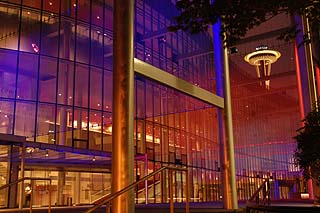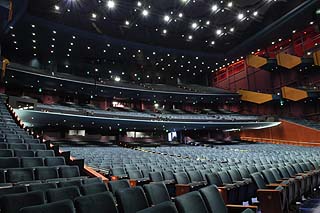
Surveys
AIA Awards
DJC.COM
November 20, 2003
Technology takes center stage in performance halls
CDi Engineers

Photos courtesy of CDi Engineers
Mechanical engineers designed independent ventilation zones for the extensive lobby areas at McCaw Hall.
|
“Build it and they'll come.”
Wrong — at least for performance halls.
Today's performance halls must meet a host of complicated and sometimes conflicting demands from performers, audiences, back-of-house crews, government agencies and owners. Designing to these expectations has changed the role of mechanical engineers for new and renovated halls — requiring a lot of research and creative thinking — devising solutions that will be music to everyone's ears.
What's changed? A lot. Big-name performers often won't consider coming to a venue that lacks cutting-edge technology. They want things like perfect acoustics, robust lighting capabilities, comfortable working conditions and high-tech audio and video systems.
Similarly, many urban concert-goers won't bake in the sun on blankets at the Gorge or shiver in drafty warehouses. They expect a showcase performing arts center to have a welcoming lobby, excellent ventilation and precision-controlled temperatures.
Another trend is the rise in complex environmental and energy-efficiency statutes from regulatory groups. And then, of course, there are always budget restraints.
Fortunately, engineers like a challenge. The winds of change in performance hall design have resulted in a host of innovative solutions for structures throughout our region.
Some like it hot
Just heating or cooling the stage can be problematic. Ballet dancers like warmer temperatures, 75 degrees or above, so their muscles stay limber. Opera singers, on the other hand, like the stage to be 70 degrees or below.
Older stages had only rudimentary heating, and were often not ventilated at all. Modern stages like Seattle's McCaw Hall, however, feature variable temperature and airflow controls that can be set to suit performers and other workers. They have to be capable of handling special effects during a performance, such as the use of dry ice.
On-stage heating and ventilation systems must be located so they won't interfere with the incredible amount of theater rigging equipment, which takes priority. Systems also cannot ripple the curtains and backdrops on the stage, which can be distracting to the audience. It takes careful planning by mechanical designers to ensure that everything fits into the space, is well coordinated and functions properly.
In the auditoriums of large halls, it's no longer good enough to allow the audience in ground-level seats to be slightly cool while the balconies, where warm air naturally rises, are balmy. Modern facilities like McCaw Hall and Bellevue's proposed Performing Arts Center for the Eastside (PACE) feature displacement ventilation systems with conditioned air supplies introduced at the level where people actually sit, rather than 30 feet above their heads.
Also, ventilation in modern facilities is delivered to various zones separately. The orchestra level and balcony levels can be heated or cooled independently, resulting in greater comfort and reduced energy costs.
Air zoning can often be introduced in renovation projects, too. The Mt. Baker Theater in Bellingham has an air displacement system dating from the late 1920s. It will be retrofitted using a zone-concept system, segregating air supplies between the main level and balcony sections to enhance audience comfort.
Smart sensors

At McCaw Hall, transition areas such as stairways do not require dedicated heating or air conditioning for comfort, resulting in energy efficiencies.
|
A full house on opening night requires much more fresh ventilation than an empty hall during rehearsals. Rather than waste resources during off-peak usage periods, special sensors placed throughout performance halls can now detect the amount of carbon dioxide being exhaled, and automatically adjust the amount of air to be delivered.
Ten years ago, CO2 sensors were virtually unknown in concert halls. Today they are becoming more common, particularly in state-of-the-art facilities like those being constructed around Puget Sound.
Awesome acoustics
One of the most important considerations when engineering a superior-quality performance hall is the room acoustics. The mechanical systems must be designed to remain silent (below detection by the human hearing system) and not adversely affect the natural room acoustics. Some opera performers have been known to refuse to go on stage until the “noisy” air conditioning systems are turned off. This is unacceptable in today's performing arts centers.
With halls now demanding quieter performing spaces, mechanical engineers must use low-noise generating fans, a series of duct-mounted silencers and other noise-absorbing materials to achieve the desired noise levels.
Lifts in the pits

Zoned temperature allows sections of modern performing arts halls, such as McCaw Hall, to be heated separately, for energy economy when the hall is not fully occupied.
|
McCaw Hall has split mobile lift platforms incorporated in the orchestra pit, just below and in front of the stage. The lifts can be moved upwards to extend the stage, or downwards to create a larger pit area. Traditionally, orchestra pits have been very hard to heat and air condition due to restricted space for mechanical systems. However, when the pit is constantly changing dimensions, the task is much more difficult.
Engineers arrived at an innovative answer — creating air plenums beneath the movable stage platforms. The plenums are served with supply ducts that can accommodate all possible positions of the lifts. The concept has proven to be so successful that it will also be adopted at PACE in Bellevue.
Lots going on in lobbies
Foyers of performance halls are increasingly being used as social spaces in their own right. In many older halls, lobbies were merely transit areas. Today they provide a venue for prefunction events and food and drink services before a performance, and they are often rented out when the hall itself is closed for weddings, receptions and parties. That means that air treatment systems must operate independently of the auditorium for energy economy.
One solution that is working well for McCaw Hall's lobby is the use of radiant floor heat. The lobby is unusually tall, and more heat is needed at the entry areas than the upper areas. Engineers installed radiant floors, an application rarely seen in commercial construction, but perfect for transitional areas where doors are constantly being opened and shut. The warm floors keep people comfortable while standing or sitting in the entry level of the lobby and do not over-heat the upper balcony levels.
Cool chorus rooms
Make-up mirrors encircled by lights are a must for performers back stage. When you have several dozen mirrors crammed into one dressing room, each with its own bank of lights, temperatures can soar.
The Mt. Baker Theater in Bellingham has two dressing rooms for choruses with about 20 make-up stations each. The rooms have a tremendous need for cooling when in full use (a very small percentage of the time), but can easily be over-cooled when in partial use.
To maintain superior comfort and energy efficiency, engineers used equipment that is sequentially controlled. In partial-use mode, just the first stage is required. Only during periods of high cooling demand is the additional cooling capacity ramped up to meet the load.
As an overall trend, we're seeing that engineering solutions for performance halls build on one another. Each terrific idea generates calls for an encore in similar projects in the region — helping to make Western Washington one of the nation's truly great venues for entertainment and the arts.
Norm Brown is an associate at CDi Engineers, a mechanical engineering consulting firm in Lynnwood.
Other Stories:
- Today's buildings load up on technology
- Letting rainwater reign in the design process
- Church praises the benefits of adaptive re-use
- UW builds on design leadership training
- Science studies how architecture affects the brain
- China creates a park with environmental appeal
- How the Great Fire changed Seattle's architecture
- Architects play catch-up in the business world
- Designing with nature in the balance
- 12 keys to creating authentic people places
- Monorail to move urban design as well as people
- Water tower repairs borrow on building technology
- In hospitals, spending more can save money
- Don't be violated — protect plans with copyrights
- Special dampers may shake up engineering field
- UW Allen Center fosters a culture of research
- Here's why projects need to be commissioned
- Unwrapping modern building envelopes
- Lessons on sustainability, Scandinavian style
- Building a highrise on the fault line
- How to keep development from killing trees
- Rx for changing healthcare industry: Good design
- Muckleshoot project blends culture with design
Copyright ©2009 Seattle Daily Journal and DJC.COM.
Comments? Questions? Contact us.